
Naval Infantry
The support of the Navy to the revolution is the stuff of legend, but much of that legend is well, untrue.
The importance of the navy in the very early days was largely due the enormous numbers of sailors that were based in Petrograd. Much of the army was similarly inclined politically, but it was both more tired by the fighting – whereas the sailors were still itching for a fight having sat in port all war – and were not from Petrograd. In the October revolution the reserve guards regiments were as important as the Navy, but most of them just went home, whereas Petrograd was the sailors' home.
It became clear fairly early in the piece that the sailors weren't very inclined to Bolshevism. The final result was the Kronstadt revolt, but it had been brewing for a long time before that. In fact large numbers of sailors fought for the Whites, especially away from the Baltic.
The number of Red sailors who fought as infantry was never very large. But in 1918 even a few hundred organised and motivated men was a sizeable force, so they gained a high reputation.
After that their importance dropped, and the remaining men were often drafted into Red Army regiments. More often they were used to man the guns of the armoured trains, and to crew the significant numbers of vessels in the various river and sea flotillas.
The only time significant numbers of sailors fought as infantry in the second half of the war was in the defence of Petrograd. (See the bottom of the page.)
Wargaming with Red Sailors
In 1918 the sailors who fought at infantry should be given high morale, but lower ratings for actual effectiveness. The MGs and artillery were areas of expertise, so they should be good. A unit of them could appear on any front.
In 1919 there were still plenty of of sailors still in the lines. A few battalions at the Petrograd front, what appears to have been a regiment facing the Markov Division near Elets and at least one battalion in the Soviet attack on Tsaritsyn (possibly attached to their Volga flotilla), so sizeable numbers were still present here and there.
Virtually every large river had a flotilla from very early in the war, and often growing quite substantial. They were often used to support land operations, as the naval equivalent of armoured trains.
Uniforms
The uniforms worn were the Tsarist era ones, with the insignia removed. New insignia was organised, but the pictures of those on land never seem to have it.
I am only interested in the uniforms for non-officer ranks, because the officers who became Red commanders mostly stayed on the boats. The AST book has their uniforms.
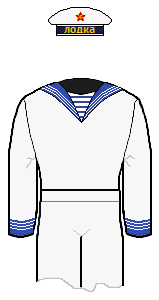 |
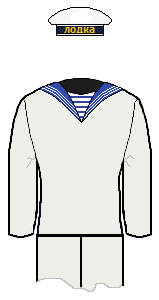 |
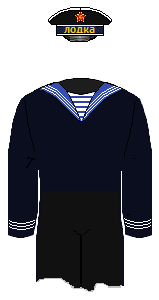 |
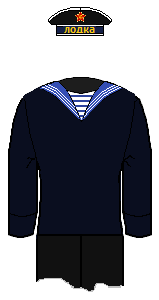 |
| Dress summer uniform | Work summer uniform | Dress winter uniform | Work winter uniform |
The summer uniform was white linen shirt, with a mid-blue collar which hung down square at the back, edged with three white stripes, and in principle, three white stripes around the cuffs. Trousers were white. The white soon became off-white with use. The under-shirt was a collarless cotton in blue and white stripes, visible at the neck.
The winter uniform was dark blue flannel shirt, with the same collar in mid-blue with three white stripes around the edge. Same undershirt. Trousers were black, over or tucked inside black boots.
The hat was black with white piping. The band had the name of the ship in gold on a white piped dark silk band, the two ends of which dangled down the back. (Some battleships, guards and the Black Sea fleet had bands in orange and black.) In summer a white cover was often worn over the crown. The cap was peakless for sailors, but petty officers had a small peak.
For cold weather there was a double-breasted black cloth pea jacket with turndown collar, and two rows of gold (brass?) buttons. The number of buttons seems to vary.
The sailors were proud of their uniform, but tended to wear it in a very scruffy and menacing manner – hats squashed up and worn at alarming angles, acquired gear (leather jackets and bandoleers being particularly liked) and long hair for the era.
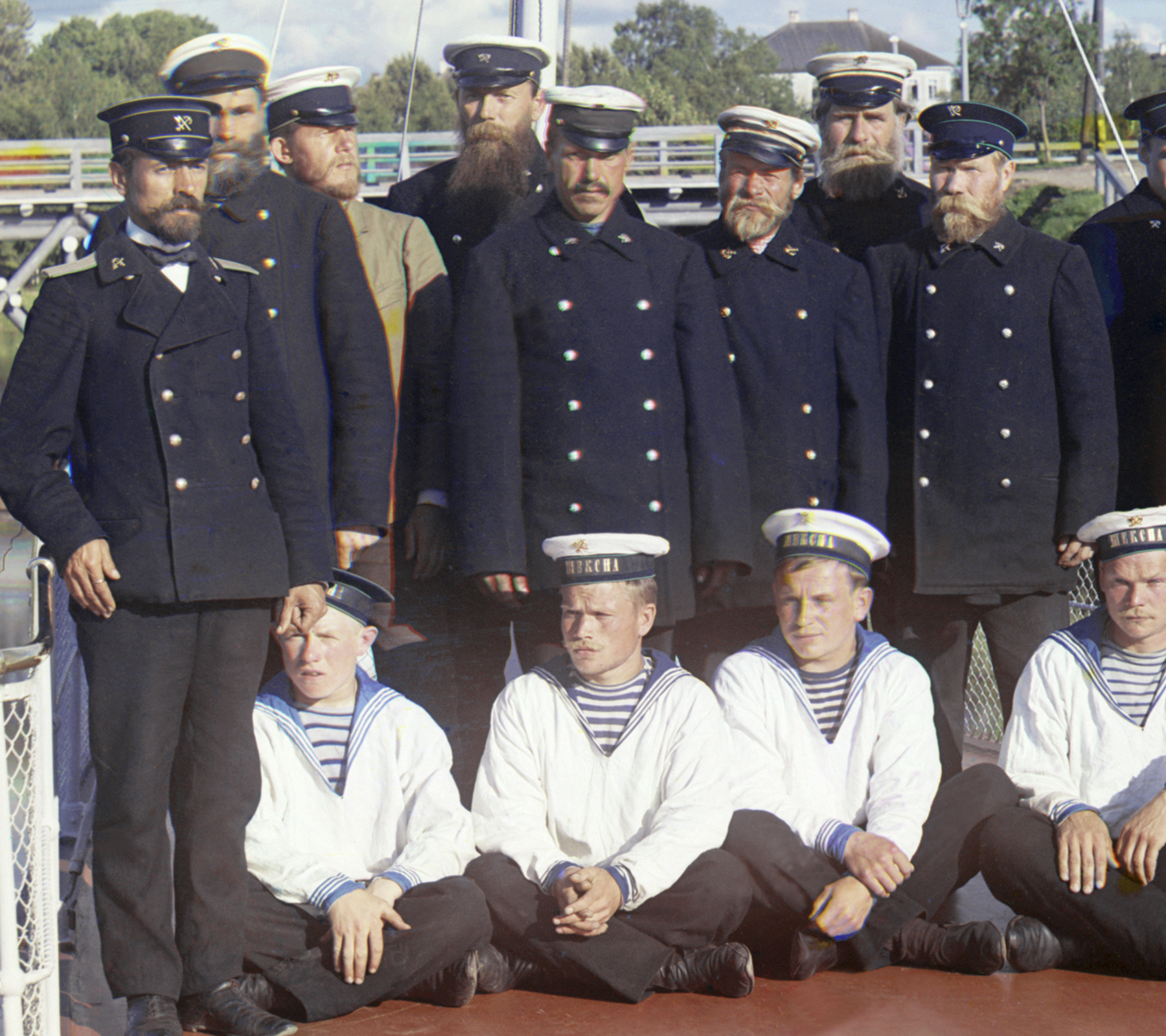
Unusually, a 1910 photo originally in colour. From a river boat (hence the different badge).
Note that the officers are wearing very dark blue coats, not black. This is normal for most
navies, and I wonder if it wasn't true for the Tsarist one as well.
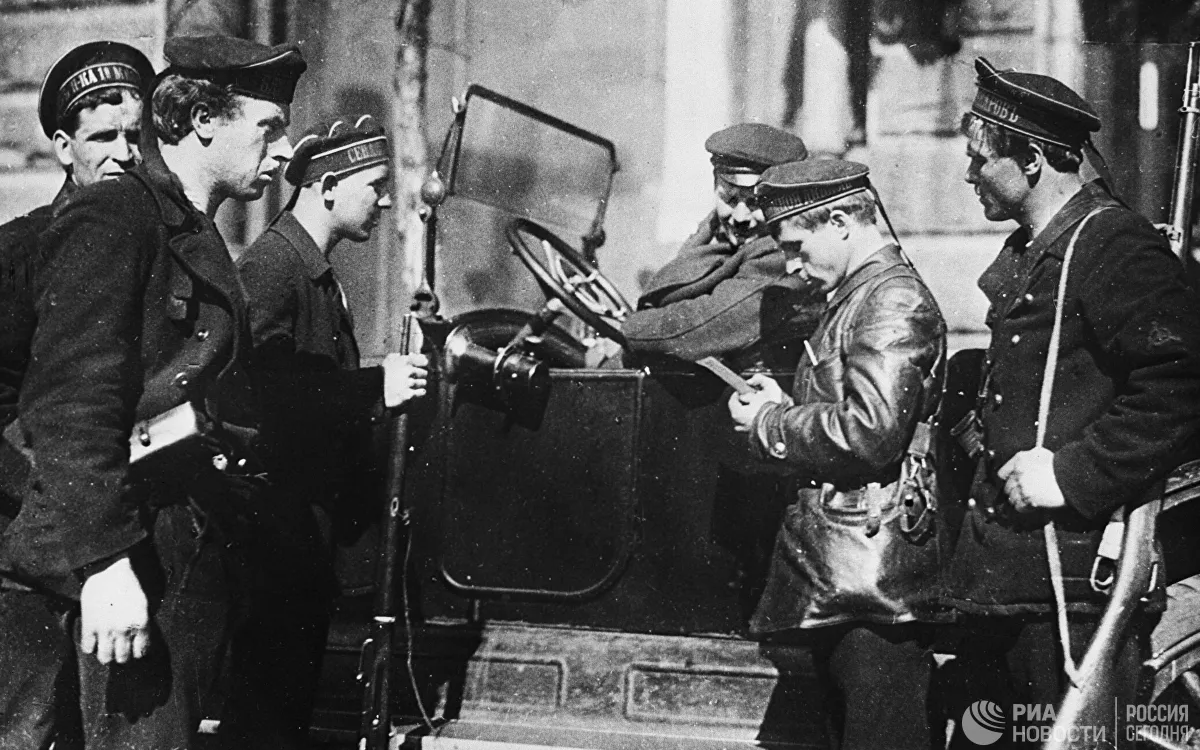
Sailors in Petrograd in 1917. Of interest is the way that the middle two have removed the stiffeners from
their hats and some have pushed the crown right back. This was to remain a common practice in Soviet
forces until the end of the war. The others appear to have bent the stiffeners to force the crown upright.
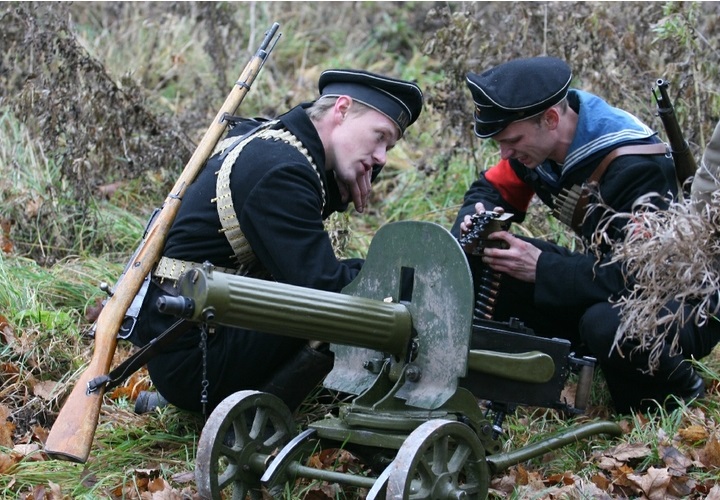
Re-enactors with a maxim. The one on the left has a cap band that looks more blue than black, which is
common. The one on the right has a cap with a visor, implying a petty officer. The overall effect is way
too tidy to be 1918 sailors. These represent the defence of Petrograd in 1919.
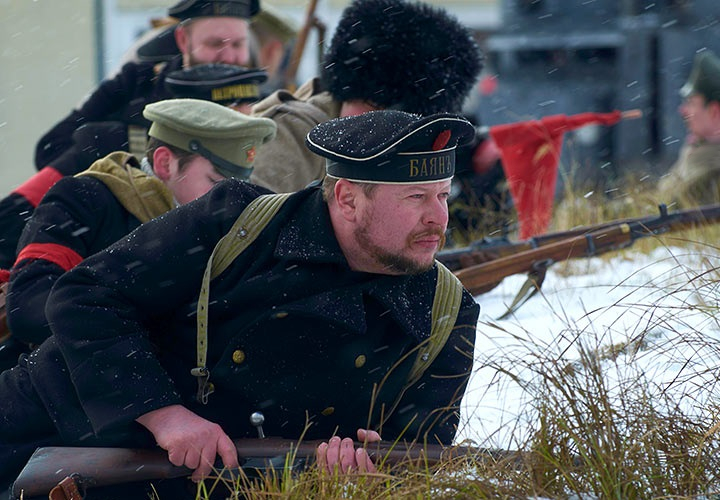
More re-enactors. Once on land the sailors tended to start to pick up normal army kit, giving a very
mixed effect, with some ex-infantry gear worn mixed with naval gear.
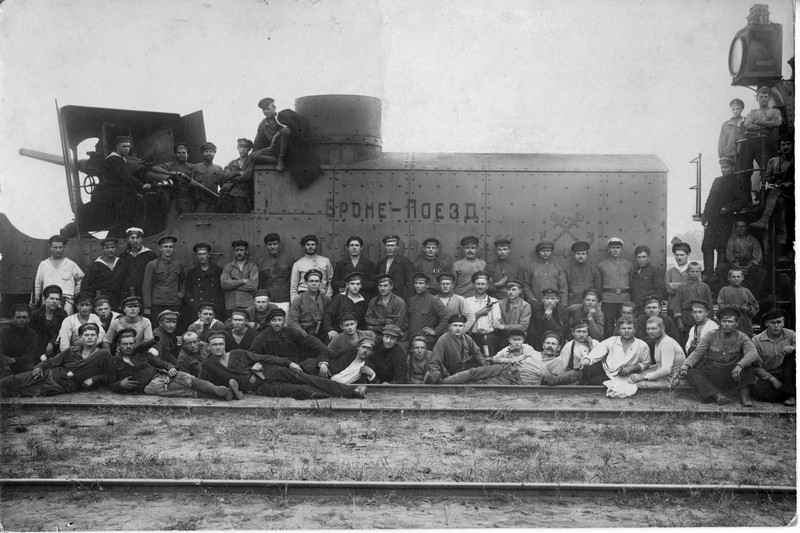
The armoured train "Grozny". Many of the crew are clearly sailors, and the crossed anchors painted on the
side suggest most are. The mix of naval and other uniforms after some time in the field is clearly seen.
Sources
There's surprisingly little about the soldiers who fought on land, given their high profile.
AST's book on the White Army has a decent section on their official uniforms.
Naval Units participating against Iudenich in October 1919
This is taken from a set of documents in "Baltic Sailors in the Struggle for Soviet Power in 1919", Leningrad, 1974. Slightly different versions give slightly different numbers and dates, but the essentials remain. The men were almost all deployed near Krasnaia Gorka.
1st Expeditionary Detachment: one battalion of 429 men, 8 MGs, from Petrograd
8 September to 15 November
2nd Expeditionary Detachment: one battalion of 246 men from Kronstadt, 396 men from Petrograd, 4 MGs
13 October to 15 November
3rd Expeditionary Detachment: one battalion of 905 men from Kronstadt and one battalion of 980 men from Petrograd, 15 MGs
15 October to 20 November
4th Expeditionary Detachment: one battalion of 771 men from Kronstadt and one battalion of 301 men from Petrograd, 13 MGs
16 October to 11 November
1st Independent Petrograd Battalion: 525 men and 6 MGs from Petrograd
15 October to 16 November
2nd Independent Kronstadt Battalion: 659 men from Kronstadt
31 October to 14 November
3rd Independent Petrograd Battalion: 641 men from Petrograd
20 October to 16 November
Emergency Detachment Naval Kursanty: 420 men from Naval Training, 100 men from Submarine Training
16 October to 14 November
1st March Company: 145 men from Petrograd
21 October to 14 November
2nd March Company: 205 men from Petrograd
16 October to 6 November
Blocking Detachment: 35 men
Armoured Train Nr 38, Black Sea
So, over 6,000 men plus 500 kursanty were mobilised from Naval forces for the defence of Petrograd.
What I find interesting is that almost all of them were deployed for basically one month. This suggests that they were a stop-gap measure only.